| Sun, Oct 4 | Mon, Oct 5| Tue. Oct 6 | Wed, Oct 7| Thu, Oct 8|

| Sunday, October 4, 2009 | |||
| 18:00-20:00 | Welcome Reception | ||
| Monday, October 5, 2009 | |||
| 8:45-9:00 | Opening & Welcome | ||
| 9:00-10:00 | Session 1 | Archive architectures - 1 | Pedro Osuna ESA New Generation Archives: Application of state of the art re-engineering to SOHO and EXOSAT Science Archives PDF Rick Ebert 20 Years of Software Reuse and Data Curation in the NASA/IPAC Extragalactic Database |
| 10:00-11:15 | Coffee Break & Focus Demo | ||
| 11:15-12:15 | Session 2 | Archive architectures - 2 | Xiuquin Wu Spitzer Heritage Archive PDF Trey Roby Archive Web sites using AJAX & GWT PDF |
| 12:15-14:15 | Lunch | ||
| 14:15-15:15 | Session 3 | "Most dangerous" Practices/Large Systems - 1 | Nuria Lorente The Science Data Model for ALMA and EVLA: The Triumphs and Pitfalls of Software Sharing and Reuse PDF Brian Glendenning Status of ALMA Software PDF Takeshi Nakazato Current Status of Single-Dish Data Analysis Software for ALMA PDF Wei-Hao Wang SIMPLE Imaging and Mosaicking PipeLinE PDF |
| 15:15-16:30 | Coffee Break | ||
| 16:30-17:30 | Session 4 | Large Systems - 2 | James Lewis Pipeline Processing for VISTA Juan Vallejo Flexible operations planning data repository for space science missions PDF Yoshiyuki Yamada Design of Astrometric Mission(JASMINE) by applying Model Driven System Engineering Joseph Pollizzi The Science and Operations Center for the James Webb Space Telescope PDF |
| 17:30-17:45 | Break | ||
| 17:45-19:00 | BoF | ||
| Tuesday, October 6, 2009 | |||
| 8:45-10:00 | Session 5 | Time Domain, Transients, Planets -1 | Pavlos Protopapas The Time Series Center: A next generation search engine using semantics, machine learning, and GPGPU Arnold Rots When Time Is of the Essence PDF Rob Seaman Transient Response Astronomy: How & Why PDF Ashish Mahabal Mixing Bayesian Techniques for Effective Real-time Classification of Astronomical Transients PDF |
| 10:00-11:15 | Coffee Break & Focus Demo | ||
| 11:15-12:15 | Session 6 | Time Domain, Transients, Planets - 2 | Bruce Berriman The NASA Exoplanet Science Institute Archives: KOA and NStED PDF David Ciardi An Overview of the Kepler Science Analysis System Roy Williams The US-VAO Facility for Rapid Transients |
| 12:15-14:15 | Lunch | ||
| 14:15-15:30 | Session 7 | Time Domain, Transients, Planets - 3 / Solar Physics | Carl Grillmair The Palomar Transient Factory Pipeline and Archive PDF Hitoshi Negoro Real-time X-ray transient monitor and alert system of MAXI on the ISSPDF David McKenzie Cycles of Activity: Acquiring, Preparing, and Exploiting X-ray Images of the Solar Corona |
| 15:30-16:30 | Coffee Break | ||
| 16:30-17:30 | Session 8 | Large Systems - 3 | Daniele Gardiol BAM/DASS: data analysis software for sub-microarcsecond astrometry devicePDF William O'Mullane Java and High performance computing in Gaia processing PDF Stephan Ott The Herschel Data Processing System "HIPE and pipelines" up and running since the start of the mission PDF Nicolas Morisset Critical Design Decisions of The Planck LFI Level 1 Software PDF |
| 19:00-21:00 | Banquet | ||
| Wednesday, October 7, 2009 | |||
| 9:00-10:00 | Session 9 | Hardware Architecture / Algorithms | Yoshihiro Chikada AD Conversion Revisited in the Frequency Domain PDF Ninan Philip Photometric determination of quasar candidates PDF Taihei Yano Centroiding experiment for determining the positions of stars with high precision PDF |
| 10:00-11:15 | Coffee Break | ||
| 11:15-12:15 | Session 10 | Web 2.0, New Software Technology | Paul Marganian Web 2.0 and Other New Software Techniques for Astronomy PDF Michael Kurtz Using Multipatite Graphs for Recommendation and Discovery PDF Sebastien Derriere 'SAMP'ling your browser for the Semantic Web PDF |
| 12:15-14:15 | Lunch | ||
| 14:15-15:15 | Session 11 | Visual Applications - 1 | Ajit Kembhavi Data Visualisation, Statistics and Machine Learning PDF Pierre Fernique Another way to explore the sky: HEALPix usage in Aladin full sky mode PDF Christopher Fluke Visualization-directed interactive model fitting to spectal data cubes PDF |
| 15:15-16:30 | Coffee Break | ||
| 16:30-17:30 | Session 12 | Visual Applications - 2 | Matthew Schneps Different Displays for Different Brains: How Neurology of Vision Effects Data Interpretation PDF Vladimir Gorohov Cognitive imaging in visual data-driven decision-support systems PDF Jonathan Fay WorldWide Telescope: A system of components enabling institutions to create rich web based data access and visualization tools |
| 17:30-17:45 | Break | ||
| 17:45-19:00 | BoF | ||
| Thursday, October 8, 2009 | |||
| 9:00-10:00 | Session 13 | Virtual Observatory - 1 | Bob Hanisch The Virtual Observatory: Retrospective and Prospectus PDF VAMDC: The Virtual Atomic and Molecular Data Centre Chenzhou CUI A VO-driven National Astronomical Data Grid in China PDF Igor Chilingarian Transparent scientific usage as the key to success of the VO |
| 10:00-11:15 | Coffee Break | ||
| 11:15-12:15 | Session 14 | Virtual Observatory - 2 / Development Tools & Environments | Masatoshi Ohishi Lessons Learned during the Development and Operation of Virtual ObservatoryPDF Franck Le Petit Theoretical Virtual Observatory services at VO-Paris Datacentre Alain Coulais Status of GDL - GNU Data Language PDF |
| 12:15-12:30 | Closing Remark | ||
